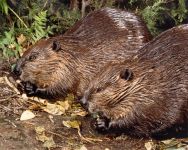


|

|
|
 
|

|
Beaver Tales from Unexpected Wildlife Refuge, Feb 2020 |
|---|
We are delighted to report on the progress that has been made with the construction of our new headquarters. The outer structure is almost complete, the windows and doors are almost all in and the plumbing and heating is being installed. Below are some photos that illustrate the progress. This project has only been possible because of the generosity of you, our supporters. We are extremely grateful to everyone who has already donated, including a recent gift of $20,000 from an anonymous source.
We still need, however, to raise a further $85,000 in order to complete the project. If you have not yet donated -- or would like to provide additional funds -- we hope you will help us in this time of need:
All donations for this much needed infrastructure will help to ensure long term stability for the Refuge by providing for office space and accommodations for our residential manager. As many of you who have visited the Refuge know, having someone live and work onsite maximizes our ability to protect this wonderful habitat, which provides a unique haven for wildlife, including species officially listed as endangered or threatened in New Jersey.

Leor Veleanu |

Dave Sauder |

Dave Sauder |

Dave Sauder |
We -- and the wildlife -- are grateful for your continued support!